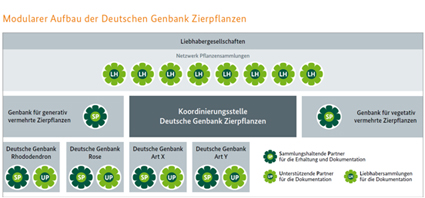The development of the German Genebank for Ornamental Plants began with the establishment of the German Genebank Rose in 2009 at the Europa-Rosarium Sangerhausen as the first sub-network.
This national genebank network consists of individual collection-specific networks.
Further partners are the German Genebank Rhododendron, the Genebank for sam propagation species as well as the network plant collections of the hobby societies.
The German Genebank for Ornamental Plants is coordinated by the Coordination Centre for Biological Diversity (IBV) of the Federal Agency for Agriculture and Food (BLE).
The common goal is to secure the enormous diversity of ornamental plants for the future. In Central Europe alone, there are currently about 80,000 species and varieties in the standard assortment of traders. The extraordinary importance of the EUROPA-Rosarium Sangerhausen as the largest rose collection in the world is reflected in the collection stock of over 8,600 rose varieties and wild species.

The city of Sangerhausen already gave the Europa-Rosarium an open-ended and free mandate in 2005 to establish a rose gene bank with the associated reference collection. Within the framework of a model and demonstration project (2004 - 2007) funded by the Federal Ministry of Food, Agriculture and Consumer Protection (BMELV), the functional prerequisites for the establishment of the German Rose Genebank were created. The state of Saxony-Anhalt is participating in the stabilisation of the gene bank network through follow-up projects with limited time and funding. In recent years, EU funds from the European Agricultural Fund for Rural Development (EAFRD) have been obtained. However, for a sustainable consolidation of the Rose genebank according to national and international quality standards, open questions of permanent funding by the federal and state governments urgently need to be clarified.
For further, detailed information, please use the download area and personal contact.